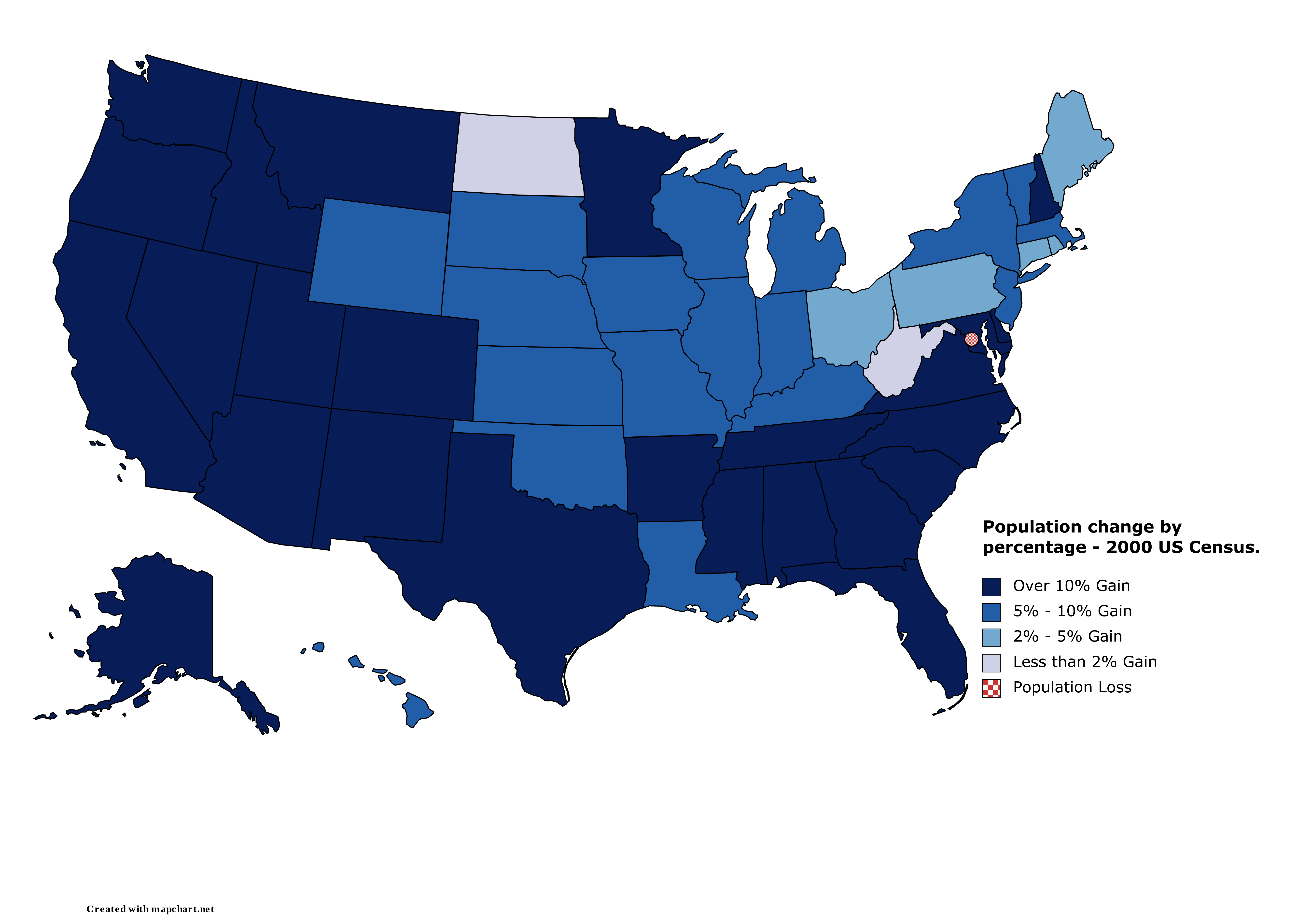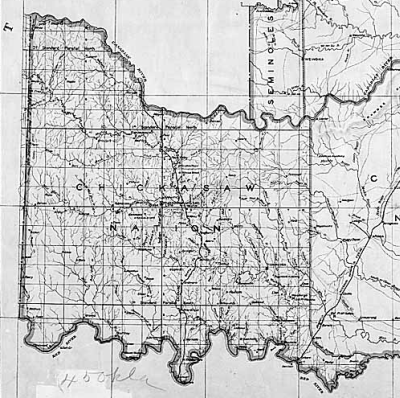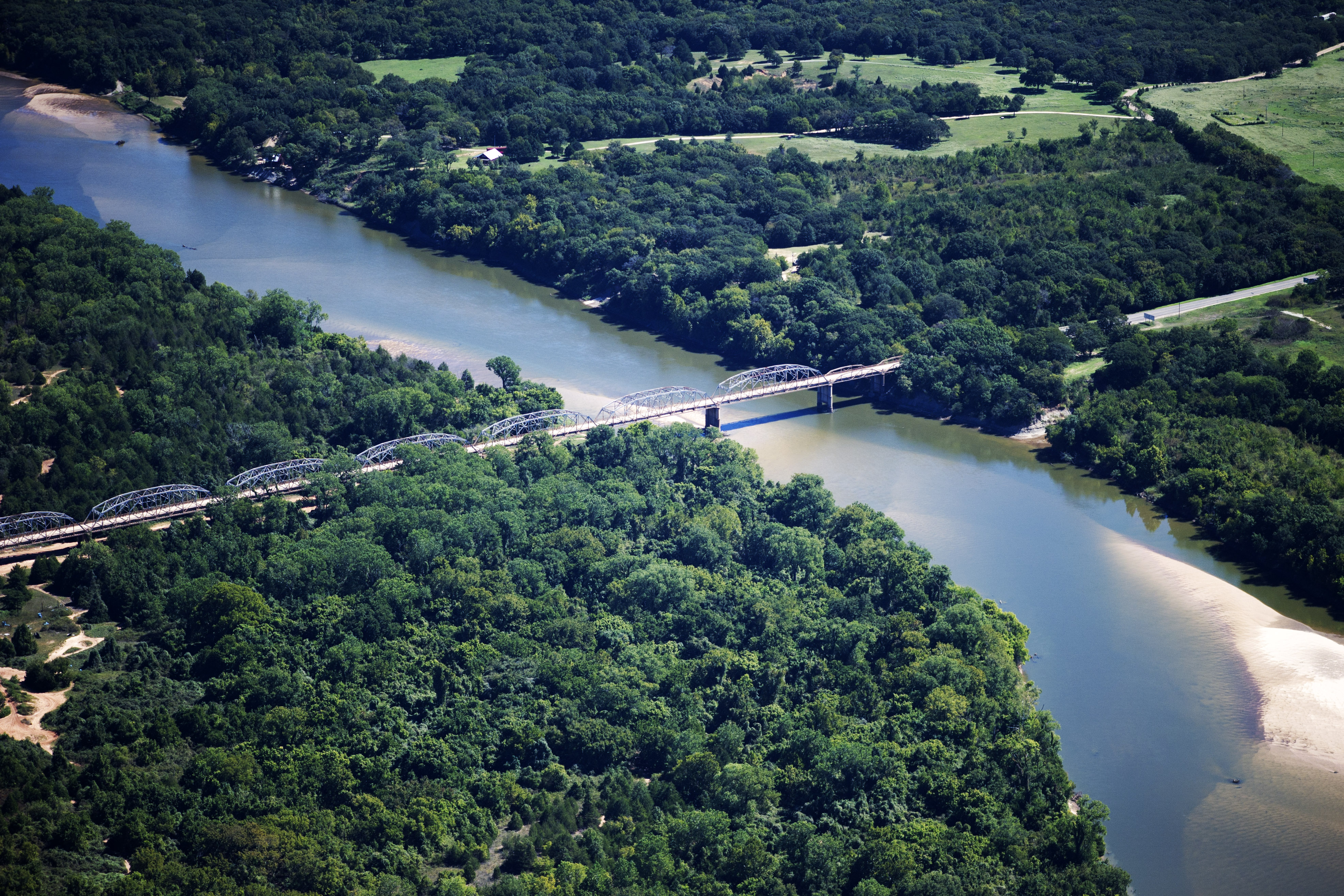|
Thackerville
Thackerville is a town in Love County, Oklahoma. It is located in South Central Oklahoma. The population was 445 at the 2010 census. It is part of the Ardmore, Oklahoma Micropolitan Statistical Area. Geography Thackerville is located at (33.795874, -97.143677). It is situated near the intersection of U.S. Highway 77 and State Highway 153, five miles north of the Texas state line and ten miles south of Marietta in south central Love County. Interstate 35 passes through town, putting Thackerville on the main route between Oklahoma City and Dallas/Ft. Worth. According to the United States Census Bureau, the town has a total area of , all land. History Thackerville was founded in the mid-19th century. The community is named after Zacariah Thacker, a pioneer from Arkansas. It is believed that he was headed for the Amarillo, Texas area, but he camped one night at Wolf Hollow Creek in Indian Territory and remained there until his death a few years later. Thacker befriended some of ... [...More Info...] [...Related Items...] OR: [Wikipedia] [Google] [Baidu] |
Oklahoma State Highway 153
U.S. Highway 77 (US-77) in Oklahoma is a U.S. Highway in the U.S. state of Oklahoma. It travels from south to north, paralleling Interstate 35 (I-35), connecting Texas to Kansas through the central part of the state. It travels through many major cities, including Ardmore, Oklahoma City and its suburbs, Guthrie, and Ponca City. It has four lettered spur routes. US-77 was the first highway in Oklahoma to be paved entirely across the state from state line to state line. It has been a paved roadway since 1930. Route description US-77 enters the state along with I-35 but splits off at the first exit in Oklahoma. Four miles later, it passes through Thackerville. It junctions with State Highway 32 on the west side of Marietta. North of Marietta, US-77 passes to the west of Lake Murray and its state park. It then enters Carter County and Ardmore, where it is named Commerce Street through the city limits over a four-lane divided thoroughfare that includes frontage ro ... [...More Info...] [...Related Items...] OR: [Wikipedia] [Google] [Baidu] |
Love County, Oklahoma
Love County is a county on the southern border of the U.S. state of Oklahoma. As of the 2010 census, the population was 9,423. Its county seat is Marietta. The county was created at statehood in 1907 and named for Overton Love, a prominent Chickasaw farmer, entrepreneur and politician. Susan L. Webb, and Sandra L. Thomas. "Love County," ''Encyclopedia of Oklahoma History and Culture'' 2009. Accessed April 4, 2015. For tourism purposes, the Oklahoma Department of Tourism includes Love County in [...More Info...] [...Related Items...] OR: [Wikipedia] [Google] [Baidu] |
WinStar World Casino
WinStar World Casino and Resort is an American tribal casino and hotel located in Thackerville, Oklahoma, near the Oklahoma–Texas state line. It is owned and operated by the Chickasaw Nation. The casino opened as the WinStar Casinos in 2004, and was expanded (with a 395-room hotel tower) and renamed WinStar World Casino in 2009; its of casino floor made it the world's largest casino.Lassek, P.J., "What were the odds?", ''Oklahoma Curiosities: Quirky Characters, Roadside Oddities & Other Offbeat Stuff'', p 30 In August 2013, WinStar Resorts completed a major expansion project, which added a new 1000-room second hotel tower that was divided into two phases; this also added a new casino that is attached to the tower. As a result of the completion of this expansion, the casino overtook Foxwoods Resort Casino to become the largest casino in the United States and one of the largest in the world based on gaming floor space. WinStar has over 8,600 electronic games, a 55-table poker roo ... [...More Info...] [...Related Items...] OR: [Wikipedia] [Google] [Baidu] |
Interstate 35 In Oklahoma
Interstate 35 (I-35), in the US State of Oklahoma, runs from the Red River at the Texas border to the Kansas state line near Braman for a length of .Stuve, EricInterstate Highways ''OKHighways''. 27 February 2007. I-35 has one spur route in the state, I-235 in the inner city of Oklahoma City. Route description I-35 enters Oklahoma with U.S. Highway 77 (US-77) on a bridge over the Red River in Love County, south of Thackerville. US-77 splits off at exit 1 (Red River Road) but parallels the Interstate for its entire length in Oklahoma. I-35 maintains a near–due north–south course through Love and Carter counties. I-35 provides four exits to Ardmore. After leaving Ardmore, it has a brief concurrency with State Highway 53 (SH-53) and enters Murray County and the Arbuckle Mountains. I-35 then passes through Garvin County and the county seat of Pauls Valley. North of exit 79 ( SH-145), I-35 enters McClain County. There, it passes through P ... [...More Info...] [...Related Items...] OR: [Wikipedia] [Google] [Baidu] |
Ardmore Micropolitan Area
The Ardmore Micropolitan Statistical Area, as defined by the United States Census Bureau, is an area consisting of two counties in South Central Oklahoma, anchored by the city of Ardmore. As of the 2000 census, the μSA had a population of 54,452 (though a July 1, 2011 estimate placed the population at 57,482). Counties * Carter *Love Communities *Places with more than 20,000 inhabitants ** Ardmore (Principal city) *Places with 1,000 to 5,000 inhabitants ** Dickson **Healdton **Lone Grove ** Marietta **Wilson *Places with 500 to 1,000 inhabitants **Springer *Places with less than 500 inhabitants **Gene Autry ** Leon ** Ratliff City ** Tatums **Thackerville *Unincorporated places ** Burneyville ** Courtney ** Enville ** Greenville ** Jimtown ** Orr ** Overbrook ** Rubottom Demographics As of the census of 2000, there were 54,452 people, 21,434 households, and 15,205 families residing within the μSA. The racial makeup of the μSA was 78.93% White, 6.72% African American, 7. ... [...More Info...] [...Related Items...] OR: [Wikipedia] [Google] [Baidu] |
2000 United States Census
The United States census of 2000, conducted by the Census Bureau, determined the resident population of the United States on April 1, 2000, to be 281,421,906, an increase of 13.2 percent over the 248,709,873 people enumerated during the 1990 census. This was the twenty-second federal census and was at the time the largest civilly administered peacetime effort in the United States. Approximately 16 percent of households received a "long form" of the 2000 census, which contained over 100 questions. Full documentation on the 2000 census, including census forms and a procedural history, is available from the Integrated Public Use Microdata Series. This was the first census in which a state – California – recorded a population of over 30 million, as well as the first in which two states – California and Texas – recorded populations of more than 20 million. Data availability Microdata from the 2000 census is freely available through the Integrated Public Use Microdata S ... [...More Info...] [...Related Items...] OR: [Wikipedia] [Google] [Baidu] |
Chickasaw Nation
The Chickasaw Nation ( Chickasaw: Chikashsha I̠yaakni) is a federally recognized Native American tribe, with its headquarters located in Ada, Oklahoma in the United States. They are an Indigenous people of the Southeastern Woodlands, originally from northern Mississippi, northernwestern Alabama, southwestern Kentucky, and western Tennessee. Today, the Chickasaw Nation is the 13th largest tribe in the United States. Currently, the nation's jurisdictional territory and reservation includes about 7,648 square miles of south-central Oklahoma, including Bryan, Carter, Coal, Garvin, Grady, Jefferson, Johnston, Love, McClain, Marshall, Murray, Pontotoc, and Stephens counties. These counties are separated into four districts, the Pontotoc, Pickens, Tishomingo, and Panola, with relatively equal populations. Their population today is estimated to be 38,000, with the majority residing in the state of Oklahoma. In the 17th and 18th centuries, European Americans considered the Chi ... [...More Info...] [...Related Items...] OR: [Wikipedia] [Google] [Baidu] |
Red River Of The South
The Red River, or sometimes the Red River of the South, is a major river in the Southern United States. It was named for its reddish water color from passing through red-bed country in its watershed. It is one of several rivers with that name. Although once a tributary of the Mississippi River, the Red River is now a tributary of the Atchafalaya River, a distributary of the Mississippi that flows separately into the Gulf of Mexico. This confluence is connected to the Mississippi River by the Old River Control Structure. The south bank of the Red River formed part of the US–Mexico border from the Adams–Onís Treaty (in force 1821) until the Texas Annexation and the Treaty of Guadalupe Hidalgo. The Red River is the second-largest river basin in the southern Great Plains. It rises in two branches in the Texas Panhandle and flows east, where it serves as the border between the states of Texas and Oklahoma. It forms a short border between Texas and Arkansas before enteri ... [...More Info...] [...Related Items...] OR: [Wikipedia] [Google] [Baidu] |
Pickens County, Chickasaw Nation
Pickens County was a political subdivision of the Chickasaw Nation in the Indian Territory from 1855, prior to Oklahoma being admitted as a state in 1907. The county was one of four that comprised the Chickasaw Nation. Following statehood, its territory was divided among several Oklahoma counties that have continued to the present. History The Chickasaw Indians, after being removed from the southeastern United States to Indian Territory in the 1830s, were assigned to live within the boundaries of the Choctaw Nation. In 1855 the Chickasaw Nation was established as a separate entity. The boundaries and political subdivisions of the Chickasaw Nation may be traced to Choctaw laws and legislation. Until the Chickasaws’ separation from the Choctaw Nation in 1855, the Choctaws divided their territory into four major administrative and judicial regions, or districts. Although the Chickasaw were free to live anywhere within the Choctaw Nation they chose, most were concentrated in it ... [...More Info...] [...Related Items...] OR: [Wikipedia] [Google] [Baidu] |
Atchison, Topeka, And Santa Fe Railway
The Atchison, Topeka and Santa Fe Railway , often referred to as the Santa Fe or AT&SF, was one of the larger railroads in the United States. The railroad was chartered in February 1859 to serve the cities of Atchison, Kansas, Atchison and Topeka, Kansas, and Santa Fe, New Mexico. The railroad reached the Kansas–Colorado border in 1873 and Pueblo, Colorado, in 1876. To create a demand for its services, the railroad set up real estate offices and sold farmland from the land grants that it was awarded by United States Congress, Congress. Despite being chartered to serve the city, the railroad chose to bypass Santa Fe, due to the engineering challenges of the mountainous terrain. Eventually Santa Fe Southern Railway, a branch line from Lamy, New Mexico, brought the Santa Fe railroad to its namesake city. The Santa Fe was a pioneer in intermodal freight transport; at various times, it operated an airline, the short-lived Santa Fe Skyway, and the fleet of Santa Fe Railroad Tugboa ... [...More Info...] [...Related Items...] OR: [Wikipedia] [Google] [Baidu] |
Indian Territory
The Indian Territory and the Indian Territories are terms that generally described an evolving land area set aside by the United States Government for the relocation of Native Americans who held aboriginal title to their land as a sovereign independent state. In general, the tribes ceded land they occupied in exchange for land grants in 1803. The concept of an Indian Territory was an outcome of the US federal government's 18th- and 19th-century policy of Indian removal. After the American Civil War (1861–1865), the policy of the US government was one of assimilation. The term ''Indian Reserve'' describes lands the British set aside for Indigenous tribes between the Appalachian Mountains and the Mississippi River in the time before the American Revolutionary War (1775–1783). Indian Territory later came to refer to an unorganized territory whose general borders were initially set by the Nonintercourse Act of 1834, and was the successor to the remainder of the Missour ... [...More Info...] [...Related Items...] OR: [Wikipedia] [Google] [Baidu] |
Amarillo, Texas
Amarillo ( ; Spanish for " yellow") is a city in the U.S. state of Texas and the seat of Potter County. It is the 14th-most populous city in Texas and the largest city in the Texas Panhandle. A portion of the city extends into Randall County. The estimated population of Amarillo was 200,393 as of April 1, 2020. The Amarillo-Pampa- Borger combined statistical area had an estimated population of 308,297 as of 2020. The city of Amarillo, originally named Oneida, is situated in the Llano Estacado region.Rathjen, Fredrick W. ''The Texas Panhandle Frontier'' (1973). pg. 11. The University of Texas Press. . The availability of the railroad and freight service provided by the Fort Worth and Denver City Railroad contributed to the city's growth as a cattle-marketing center in the late 19th century.. Retrieved on January 25, 2007. Amarillo was once the self-proclaimed " Helium Capital of the World" for having one of the country's most productive helium fields. The city is also ... [...More Info...] [...Related Items...] OR: [Wikipedia] [Google] [Baidu] |







